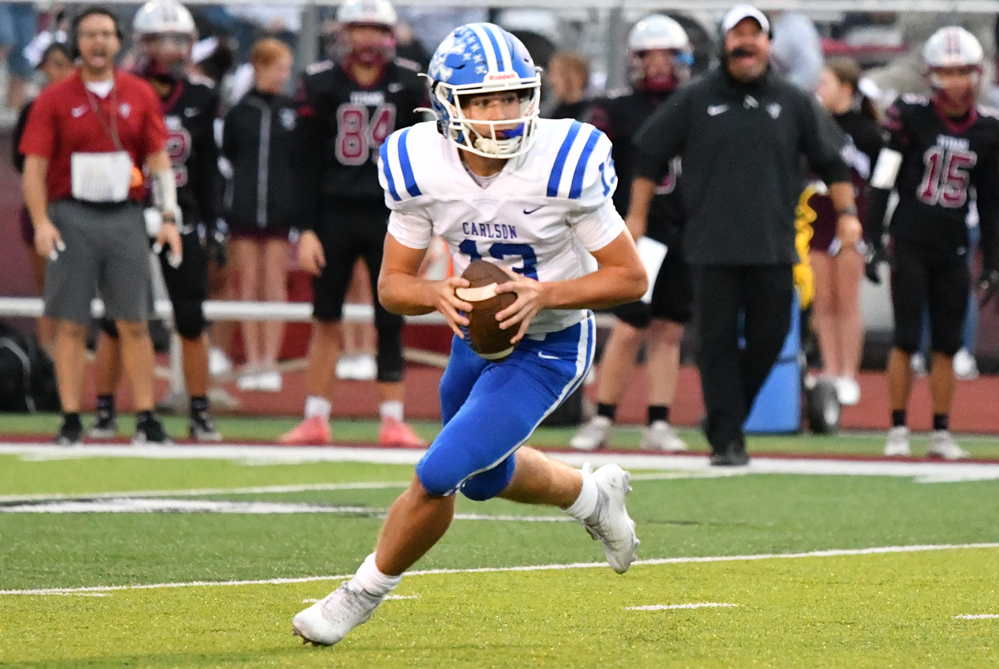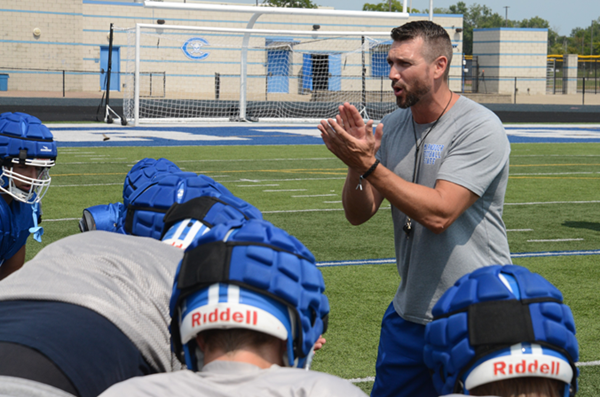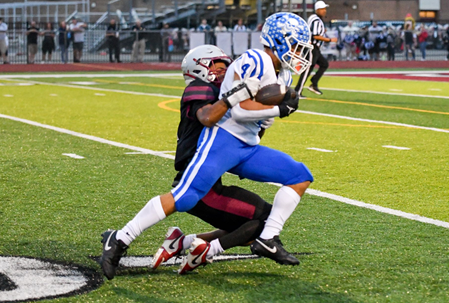
Talking Practice: Texas, Illinois Revise Policies
December 20, 2013
By Rob Kaminski
MHSAA benchmarks editor
Coaches and players in Texas and Illinois adapted to new football practice limitations this fall, with the Texas policy focusing on contact, and the Illinois regulation emphasizing length of preseason practices.
Following are the main changes those states put in place heading into the 2013-14 season:
The University Interscholastic League, which governs school sports in Texas, put into writing that, “During the regular season and postseason, no football player is allowed to participate in more than ninety (90) minutes of full contact practice per week,” effective with the first day of practice this fall.
The complete policy follows:
For the purposes of the of rule, "full contact" is defined as football drills or live game simulations where "live action" occurs. Live action, as defined by USA Football, is contact at game speed where players execute full tackles at a competitive pace taking players to the ground. A team may continue to dress in full pads for practice, but may only participate in live action drills and game time simulations no more than ninety minutes per athlete per week. It is assumed that when players are in shells (shorts, shoulder pads, and helmets) no live action drills or simulations will occur. This rule is intended to limit live action drills and simulations and not the number of practices a team may participate in full pads. A team may participate in "air," "bags," "wrap," and "thud" drills and simulations at any point. These contact levels are defined below:
• Air - Players should run unopposed without bags or any opposition
• Bags - activity is executed against a bag, shield or pad to allow for a soft-contact surface, with or without the resistance of a teammate or coach standing behind the bag.
• Wrap - Drills run at full speed until contact, which is above the waist with the players remaining on their feet.
• Thud - Same as wrap but tempo is competitive with no pre-determined winner and the players are not tackling to the ground.
 The rule came to the UIL Legislative Council as a recommendation from the UIL Medical Advisory Committee, a permanent advisory committee to the Legislative Council which meets twice each year to discuss and review safety policies for UIL participants. The committee, which is made up of leading medical professionals in various specialties and includes representatives from the Texas High School Coaches Association, the Texas Girls Coaches Association, and the Texas State Athletic Trainer Association, unanimously recommended this limitation in full-contact football practice.
The rule came to the UIL Legislative Council as a recommendation from the UIL Medical Advisory Committee, a permanent advisory committee to the Legislative Council which meets twice each year to discuss and review safety policies for UIL participants. The committee, which is made up of leading medical professionals in various specialties and includes representatives from the Texas High School Coaches Association, the Texas Girls Coaches Association, and the Texas State Athletic Trainer Association, unanimously recommended this limitation in full-contact football practice.
The rule formulates into a formal policy the existing actions of the majority of coaches across Texas, and most coaches have had to make few adjustments, if any. In fact, according to a story on statesman.com, the proposal caused more of an uproar on social media than from coaches.
“It’s not going to affect us in anyway,” Vandegrift HS coach Drew Sanders said in the story. “Most good coaches were way below that 90-minute amount already. Prior to legislation we still monitored it ourselves – the only change is now we have to keep up a log more publicly.”
Illinois put standards in place for its first 14 days of football practices, known as the state’s Preseason Football Acclimatization Practice Period. At the core of the policy is a three-hour practice limit for the first five days, during which teams can also conduct a one-hour walk-through.
 Teams must observe a minimum two hours rest between the practices and walk-throughs. Players may wear helmets only on the first two days, then helmets and shoulder pads for the next three. From days seven through 14 of the acclimatization period, schools may practice for a maximum of five hours per day, as long as that day is followed by a three-hour day, or an off day. During the five-hour days, no session can last more than three hours and must include a two-hour break between practices. Full pads may be worn for the final seven dates leading up to the first contest.
Teams must observe a minimum two hours rest between the practices and walk-throughs. Players may wear helmets only on the first two days, then helmets and shoulder pads for the next three. From days seven through 14 of the acclimatization period, schools may practice for a maximum of five hours per day, as long as that day is followed by a three-hour day, or an off day. During the five-hour days, no session can last more than three hours and must include a two-hour break between practices. Full pads may be worn for the final seven dates leading up to the first contest.
“This policy was the result of a collaborative effort between the IHSA Sports Medicine Advisory Committee and the Football Advisory Committee,” said SMAC committee member and University of Illinois Associate Professor of Orthopedic Surgery Dr. Preston M. Wolin. “The guidelines are based on the most recent scientific evidence, as well as the expertise of the coaches who will help implement them. Both committees believe the guidelines represent a significant positive contribution to the health of our athletes.”
“This new policy undoubtedly changes the way we, as coaches, approach preseason practice,” said Metamora HS coach Pat Ryan, who is a member of the FAC and a past President of the Illinois High School Football Coaches Association. “Coaches have to get more creative with when and how they schedule practices, as well what they do with their time. The proposals were strongly supported by both committees. It is a crucial final step to the process of being able to effectively prepare our teams in a safe manner. Change is always difficult, but the game is changing and we need to adapt to continue to put the safety of our players first.”
The IHSA offered multiple interactive online webinar meetings for high school coaches leading up to the start of practice where questions were answered, along with further clarifications on the policy and the science behind it.
“I think most coaches understood that changes were on the horizon,” said IHSA Executive Director Marty Hickman. “We wanted to be in a position to give our coaches as much information as possible to make sure they are comfortable with the new policy. Their input will be critical moving forward as we develop educational materials, like a best practices presentation. I commend our committees on a policy that is supported by medical experts, football coaches and school administrators.”

Carlson's 'Power-Spread' Piling Up Points Despite Missing Leading Rusher
By
Doug Donnelly
Special for MHSAA.com
October 2, 2024
In Johnny Cash’s song “One Piece at a Time,” the main character collects car parts over the years to build a one-of-a-kind automobile.
 At the end of the song, he’s asked what model it is. That’s where he runs into trouble.
At the end of the song, he’s asked what model it is. That’s where he runs into trouble.
“Well, it’s a ’49, ’50, ’51, ’52 …” Cash sings.
That automobile is a lot like the offense that has Gibraltar Carlson’s football team off to a 5-0 start.
“We pride ourselves in running the football here,” third-year head coach Jason Gendron said. “That is our identity. We play power football.”
That’s not the full story, however.
“We are multi-set, really,” Gendron said. “We have Wing-T principles, but we are a spread, Wing-T team that can go tight formations with two tight ends and three running backs. We also can go spread and run some run-pass option things. We also like to run counter off that.
“At the end of the day, power football is where we like to be. We can run that out of multiple sets. Everything we do is based off power.”
Marauders quarterback Joe Krolak agrees. Sort of.
“It’s power-spread,” Krolak said. “It’s hard to describe. We can go under center, or we can go spread.”
No matter what you call it, the Marauders’ offense is clicking in all gears. Carlson is averaging a two-point conversion shy of 50 points a game in their 5-0 start.
That Carlson is having success is not surprising or anything new. The Marauders have won four straight Downriver League championships and have made the playoffs seven years running. The surprising piece this season is they have done it without Division I college recruit Izaiah Wright, the junior running back who rushed for 1,965 yards and 31 touchdowns as a sophomore in leading Carlson to a 10-2 record.
Wright played in Week 1. But on the first offensive series of the game in Week 2, he went down with an ankle injury and hasn’t played since.
 “It’s been a slow recovery,” Gendron said. “He’s been week-to-week. He’s getting closer. I do think he’ll play again this year, but I don’t know if he will be 100 percent this year.”
“It’s been a slow recovery,” Gendron said. “He’s been week-to-week. He’s getting closer. I do think he’ll play again this year, but I don’t know if he will be 100 percent this year.”
In his place, the Marauders were sharing carries among multiple backs until last week when junior Avery Ortiz got the full workload. He responded with 200 yards rushing and multiple touchdowns.
Gendron said he and the Carlson coaches saw the potential in Ortiz.
“Avery has been the running back who has emerged,” Gendron said. “We feel Avery is one of the best backs in our conference and southeast Michigan.”
Ortiz has been Wright’s backup for a couple of seasons. Last year Gendron asked Ortiz about changing positions to get him on the field, and he started playing safety. This season, with Wright out, Ortiz found himself on the offensive side of the ball again.
“He has great vision and is really good on his cuts,” Gendron said. “Avery is a running back at heart. He’s always wanted to be the running back here, but you have a kid in front of him who is a Division I player who beat him out. That’s just the way it goes. At least he was humble enough to accept that and find another place to play. For him to get that back, seize the moment and run with it, is the credit to the type of kid he is.”
Krolak said the offense hasn’t skipped a beat with Ortiz as the featured back.
“Everybody knows in this program it’s next man up,” Krolak said. “We have a lot of athletes in this program who can do the same things he can do. Avery has really stepped up big. He’s looking phenomenal. He’s a great running back and has carried us through this.”
Gendron called Krolak the team’s first-half MVP. Krolak has completed 44 of 62 passes for 669 yards and six touchdowns and rushed for another 406 yards and nine touchdowns.
“Joe is a very dangerous runner and has gotten better at throwing,” Gendron said. “He’s a dual-threat quarterback. You can’t just key on Izaiah or Avery. You have to have eyes on Joe. He’s been the player of the year for us without question. He’s leading us and doing everything I’ve asked him to do at the position. He’s having a great year.”
Krolak, a senior, said he was ready for his number to be called more with Wright out.
“I knew I would get the ball more,” Krolak said. “Coach told me I was going to run the ball more and throw it around, and I was completely ready for it.”
 Carlson has several more weapons, including tight end Drew Sikora and receivers Brendan Stanley and Landon Vida. Everything starts up front, however.
Carlson has several more weapons, including tight end Drew Sikora and receivers Brendan Stanley and Landon Vida. Everything starts up front, however.
“I tell our offensive line that they are the most important position group on the field, both our offensive and defensive lines,” Gendron said. “They have bought in and embraced that and the fact that we want to be a power, smash-mouth football team.”
Carlson’s been pretty good on defense, too, giving up just six touchdowns all season.
Gendron is a Monroe Jefferson graduate who played for Marc Cisco, who retired after 47 years coaching the Bears. That’s where Gendron learned the fundamentals of the game and about power football.
“It works,” Gendron said. “It worked back then for Marc, and it works for us. It’s good football. I believe in it. The kids buy into it. There’s nothing better from an offensive standpoint when you can get three yards at will and you can call the play again and it works.”
The current offense is a mix of Gendron’s years playing at Jefferson and schematic strategies incorporated by Dan Kalbfleisch, the Carlson athletic director and assistant football coach.
“We’ve blended Dan’s experience with his spread concepts and the things I value about offensive football – the ground and pound, power football concepts – into one offense. Dan brings the pre-snap, tempo, no-huddle offense with motion and getting guys into space. That’s what you see. We both believe in running the football.”
Carlson has some tough games ahead, but Gendron is pleased with how the season is shaping up. With a little luck, they might get Wright back in time for a playoff run.
“We are on schedule right now,” he said. “Our guys have done what they need to do at this point. We take things one week at a time. Trenton is on the clock right now.”
 Doug Donnelly has served as a sports and news reporter and city editor over 25 years, writing for the Daily Chief-Union in Upper Sandusky, Ohio from 1992-1995, the Monroe Evening News from 1995-2012 and the Adrian Daily Telegram since 2013. He's also written a book on high school basketball in Monroe County and compiles record books for various schools in southeast Michigan. E-mail him at [email protected] with story ideas for Jackson, Washtenaw, Hillsdale, Lenawee and Monroe counties.
Doug Donnelly has served as a sports and news reporter and city editor over 25 years, writing for the Daily Chief-Union in Upper Sandusky, Ohio from 1992-1995, the Monroe Evening News from 1995-2012 and the Adrian Daily Telegram since 2013. He's also written a book on high school basketball in Monroe County and compiles record books for various schools in southeast Michigan. E-mail him at [email protected] with story ideas for Jackson, Washtenaw, Hillsdale, Lenawee and Monroe counties.
PHOTOS (Top) Gibraltar Carlson quarterback Joe Krolak considers his best option during last week’s win over Southgate Anderson. (Middle) Carlson coach Jason Gendron pumps up his team during a practice. (Below) The Marauders’ Avery Ortiz drags a defender downfield. (Game photos by Kim Britt; practice photo by Niles Kruger/Monroe News.)

